|
|
|
 |
|
|
|
 |
|
Edna Theater |
Edna Theater National Register Listing # 11000652 201 West Main Street |
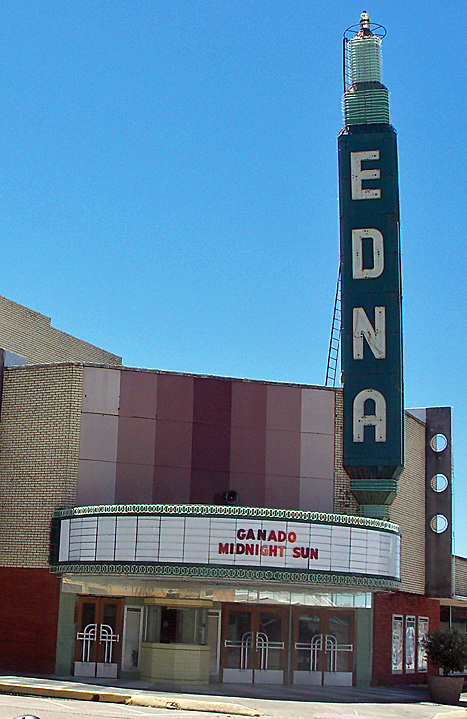 |
|
Edna Theater Courtesy of the National Register of Historic Places NARRATIVE DESCRIPTION Completed in March 1950, the Edna Theatre was constructed as a flagship location for the Long Theatre Company, which operated approximately sixty movie houses throughout central and south Texas. Situated adjacent to important civic buildings, including the Jackson County Courthouse square and Edna City Hall, this movie palace was the focal point of entertainment for Jackson County residents for nearly three decades. Designed and constructed by Houston's W. D. Peck and Company, Inc., in the Moderne style, the Edna Theatre features an enormous vertical fin that announces the name of the venue in large, illuminated letters, as well as smaller fins and a large, curving marquee with multicolored neon lights cantilevered over the street corner. Currently vacant, local residents are actively pursuing the building's restoration. The Edna Theatre is nominated to the National Register of Historic Places at the local level of significance under Criterion A for Entertainment / Recreation; and under Criterion C for Architecture. The period of significance begins with the building's completion in 1950 and ends in 1961, the current 50-year date for eligibility. Setting The Edna Theatre is prominently located on the southwest corner of the intersection of Ed Linn and Main streets (formerly Hackberry Street, then Texas Route 12, then U.S. 59, and now Loop 521) in downtown Edna, the seat of Jackson County, Texas. The theater building is adjacent to the long, rectangular public square, which is covered with a grass lawn and shaded by oak and pecan trees. The modernist Jackson County Courthouse (1954), a fiat roofed, two-story building of brick, stone, and concrete designed by F. Perry Johnson, is situated at the center-rear of the square, to the east of the theater across Ed Linn Street. The Edna Theatre is an iconic fixture within the downtown commercial district, surrounded by smaller, two-story buildings of stone and brick, nearly all constructed in the late nineteenth and early twentieth centuries; these other commercial buildings feature colorful awnings that project over the city sidewalks. In contrast, the Modeme-style Edna Theatre features a vertical fin that towers over the courthouse and the downtown, announcing EDNA when illuminated at night, and serving as the focal point or visual anchor for the commercial district. The streets of Edna were platted in 1882 as an orthogonal grid around a railroad line; as such, they run at a 45-degree angle to the points of a compass. The Edna Theatre is positioned so that patrons watching a film would be facing southwest. The building is rectangular in shape, however, its northeast corner is chamfered at a 45-degree angle so that the main entrance and marquee face true north. STATEMENT OF SIGNIFICANCE The Edna Theatre is adjacent to the county courthouse in the heart of downtown Edna, the seat of Jackson County, Texas. Between 1950 and 1978, the Edna Theatre served as an important focal point for the rural county, as "the picture show" was the most popular gathering place for young and old residents alike. Although the Edna Theatre was built to be the entertainment center for the county, it arrived just at the time when commercial television programming brought entertainment directly into people's homes, and, consequently, its popularity waned until the theater closed after less than thirty years in service. Today, a group of residents who fondly recall the excitement of the movie palace is pursuing its restoration, hoping to return the building to its place as the social center for the community. At the time of its opening on March 14, 1950, the Edna Theatre featured state-of-the-art technology and was the epitome of architectural style for a movie theater of its size. Contractor W. D. Peck & Company, Inc., of Houston, designed and constructed the Edna Theatre, which served as the flagship of the sixty theaters operated by the Long Theaters chain in central and south Texas. One thousand moviegoers could fill the single-screen auditorium and enjoy the same films being screened in larger cities around the country, and the theater was fully air-conditioned at a time when very few homes or businesses featured such comforts. The exterior and interior of the building still maintain their Moderne-styled details, including the elaborate marquee and vertical signage, brilliantly lit with multicolored neon, and its aluminum poster display cases and storefront windows. Local Significance A single-screen movie theater—the Ed Tex—opened in Edna on Monday, June 30, 1930, and it served the community until a fire destroyed the building in 1942. Due to U.S. involvement in World War II and related shortages of construction materials and capital for investment, a new theater could not be built in replacement at that time. Between 1942 and the opening of the Edna Theatre in 1950, residents throughout the largely rural Jackson County attended movie screenings in Edna in a remodeled storefront building with very limited seating capacity. Late in 1949, construction began on the Edna Theatre at the corner of Ed Linn and Main streets, and the movie palace—a spectacular in itself—opened on the evening of Tuesday, March 14, 1950. The theater was designed and constructed by W. D. Peck and Company, Inc., of Houston, for the movie theater chain of J.C. Long Theaters, Inc., of Bay City, Texas. The Long Theaters owned and operated sixty theater venues throughout central and south Texas at that time, and the Edna Theatre was as modern in its design and equipment as any of its theaters in larger metropolitan areas, including Dallas and Houston. In addition to the latest in projection and sound equipment, and the most eye-catching of marquee lighting and signage, the Edna Theatre featured "eighty tons of refrigeration [to] cool the theater in summer, and a large heating plant [to] make it equally as comfortable during the winter."' The Victoria Advocate reported that the Edna Theatre "is as modern as one can be built at this time." The final cost of construction exceeded $200,000, a large sum for its day." "With true carnival spirit," approximately 3,000 people from Edna and the surrounding towns attended the grand opening of the theater on a Tuesday night. Jackson County residents celebrated the opening of the new movie palace with a parade, followed by a concert by the Edna Cowboy Band, conducted by R.J. Kluge. On the 450-squarefoot stage in the single-screen auditorium, a short dedication ceremony was held, with L. O. Wallace of the Long Theatres chain acting as master of ceremonies; also in attendance was another Long employee, Glenn McClain, who briefly addressed the crowd. Harry Mauritz, the mayor of Edna, and Dr. R. E. Lee, president of the chamber of commerce, also spoke briefly, and Wallace introduced the audience of 1,000 to the manager of the new theater, Fred M. Smith. The first feature shown at the Edna Theatre was Father Is a Bachelor, starring William Holden and Coleen Gray; this romantic comedy, directed by Abby Berlin and Norman Foster, had just been released nationally on February 22, making its Edna debut on March 14 quite current. Many in Jackson County today fondly recall the vibrant atmosphere of the Edna Theatre and its significance as an important social center for the surrounding towns during the mid-twentieth century. Saturday matinees cost ten cents and included headline news clips, the latest adventures of a weekly serial hero, a cartoon, and one or two full length feature films. Teenagers flocked to the Edna Theatre on Saturday nights, as "the picture show" was the best place to take a date; midnight screenings of horror films also were a popular attraction for teenagers on Saturdays. Local merchants helped to bring patrons to the movie theater on Tuesdays, when people would queue all the way down the block for giveaways; the merchants donated prizes that were awarded to the lucky holders of numbered ticket stubs, or owners of cars with license plate numbers drawn by lottery. Treats at the concessions stand included popcorn for ten cents, candy for five cents, and dill pickles from a one-gallon jar. The Edna Theatre stage also was used for high school plays and talent shows, and occasionally live entertainment was also provided before a movie on Saturday night Although attendance at the Edna Theatre was very strong in its first years of operation, the opening of the theater coincided with the rise of television's popularity among American households, and over time the number of moviegoers dwindled as the number of television sets rose. The later development of television-related technologies—including home video cassette players and recorders in the mid-1970s, and the introduction of cable or "pay" television channels—also contributed to the eventual demise of the Edna Theatre. Throughout the United States, large single-screen theaters like the Edna, located in the heart of downtown, commonly fell victim to the rising popularity of multi-screen theaters associated with shopping centers and regional malls. The Edna eventually succumbed to these pressures and closed its doors in 1978. The local newspaper claimed that the Edna Theatre was "the largest and most modern [movie theater between San Antonio and Houston." Larger in size than many other single-screen theaters of the Long Theatres chain—including the Grove Theatre in Dallas, Dallas County, and the Ganado Theatre in Ganado, also in Jackson County—the Edna Theatre was certainly the chain's most opulent venue in 1950. Designed in the popular Moderne style, the building was the epitome of glamour and excitement, suggestive of Hollywood itself. The horizontality of the one-part commercial block, which includes several storefronts and a grocery store, is countered with the two-story volume that contains the 1,000-seat auditorium and its screen. Minimal decoration on the brick building allows the elaborate theater marquee and 60-foot-tall vertical signage to serve as both advertisement and the focus of ornamentation. Extensive neon lighting both inside and outside the theater, including more than one mile of neon tubing on the main facade alone, draws attention to building in the dark of night, even at considerable distance. Texas architectural historian Jay C. Henry claimed that the "Streamlined marquee and the neon-illuminated advertising beacon became the leitmotifs of [1930s] modernization," on the major thoroughfares of downtown, a pattern that continued in the postwar years in the smaller towns of Texas. Henry identifies "the suspended electric sign [that] has now become a vertical advertising pylon of monumental scale" as the dominating feature of movie theaters constructed throughout the state during this period, "the building as billboard—as an immediately recognizable trademark and advertisement for the goods and services purveyed." The Edna Theatre is one of the finer examples of a Moderne-style movie palace still extant in southeast Texas. Its integrity is excellent, as its elaborate signage, ticket booth, poster display cases, and entrances all remain in place and unchanged. The adjacent storefronts still feature their aluminum-framed display windows and their continuous bands of metal awnings, which were designed to be fireproof The interior of the theater still includes the stage, screen, and sculptural ceiling ornamentation. The Moderne railing of extruded aluminum with glassy panels of corrugated, clear acrylic still graces the interior staircase to the balcony and manager's office. A group of local businessmen, seeking to save the building from demolition and restore it to its former glory, purchased the Edna Theatre in 1986. These owners, in conjunction with the Jackson County Historical Commission, restored the marquee and most of the exterior neon lighting at a cost of nearly $30,000, much of which came from contributions from the community. In June 2008, nearly 1,200 people attended the marquee relighting ceremony, and since then the neon lights and signage have been illuminated every night between 9 and 11 o'clock. The City of Edna and the Chamber of Commerce now rent the marquee for public and private messages, and the Texana Arts Council, a local non-profit group, is currently pursuing full restoration and reuse of the Edna Theatre. Exterior Designed and constructed by W. D. Peck and Company, Inc., of Houston, the Edna Theatre was touted as "the most glamorous of the movie palaces" belonging to the Long Theatres franchise of central and south Texas. The main entrance is brightly lit with neon, and mirrored panels under the marquee and surrounding the entrance doors reflect light to attract moviegoers. Set into the green-tiled north wall under the marquee are three sets of double doors of mahogany and glass with lower kickplates and long, curving door pulls made of steel. As the theater building was designed during the era of racial segregation, the main entrance reflects this social history: two double door entrances to the right of the ticket booth were for the use of white and Hispanic patrons, while the single set of double doors to the left of the ticket booth were for the use of African American moviegoers. Terrazzo tiles on the sidewalk form gray-and-white rays that extend outward from a central ticket booth toward the street, drawing in moviegoers to purchase tickets and enter the theater. The ticket booth is clad with ceramic tiles in a soft yellow, three inches square, accented by one border row of thin, three-inch-long black tiles. The upper facade over the marquee is clad with seven vertical porcelain panels that progress from shell pink, rose pink, mauve, to rust, and return through the hues back to shell pink. The curving marquee cantilevers over the street corner, sheltering ticket buyers and those linngering before or after a screening; at night, the marquee edges are illuminated with overlapping rings of yellow neon. The tower over the marquee reaches sixty feet in height and proclaims EDNA in red-and-white neon letters, each five feet tall. Reminiscent of an idealized rocket ship, the porcelain-clad metal tower is mostly dark green, with its two progressively receding segments in lighter shades of green as it reaches toward the sky; at its point, the tower is encircled by a Saturn-like metal ring. At the base of the tower, where the sign connects to the building, segments recede in size and alternate in two shades of green as it points down toward the marquee; these lower segments are lit with red and green neon at night. The tower, marquee, and two vertical fins are brilliantly outlined in one mile of neon tubing in white, red, green, and yellow, allowing the building to attractively advertise itself even at a great distance. To ground the building, so boldly marked by the towering vertical sign, emphasis is placed on its horizontality using decorative bands of concrete and brick. The building is best described as an asymmetrical one-part commercial block constructed of clay tile and steel frame, and clad in red Roman brick, with the taller theater space articulated in buff-colored standard brick. The northeast and northwest elevations feature bands of metal-framed display windows interrupted by metal-framed glass doors at the individual storefronts. A flat metal awning protrudes from these elevations at the tops of the windows and appears as a thin, continuous horizontal band that stretches across each facade. Above the awnings to the top of the parapet, the standard buff-colored brick is used to visually connect the storefronts to the central theater volume. The parapet wall is highest at the northeast end, and it steps down by one brick every eight to ten feet toward the northwest. A protruding stack of three short horizontal bands of concrete accentuates the top corners of the building on the elevations at Main and Ed Linn streets, and a concrete cap extends along the top of the chamfered corner at the main entrance on the north. Leading the viewer's eye down from this concrete cap to the storefronts are two vertical concrete fins, each pierced with three circles, which connect to the flat metal awnings, each approximately 6 inches deep by 36 inches long; at night the six circles are outlined in red neon. At the center of the northeast facade, a striated relief ornament extends vertically from the top of the awning to the top of the parapet, and it is executed in red brick to harmonize with the red brick below, yet contrast with the upper field of buff-colored brick, which is otherwise unornamented. The historic aluminum storefront windows are intact on the northeast facade, but the aluminum-and-glass storefront door and transom (located below and between the large relief ornament and the pierced concrete fin) has been replaced with a door with two panels in its lower half, and a three-over-three light window in its upper half. At the time of the theater's opening in March 1950, the one-part commercial block on the northwest side of the building housed two businesses, a dress shop and a grocery store from the Piggly Wiggly chain. Today that commercial space houses a feed store, and its face brick has been painted gray to differentiate it from the rest of the building. Some store windows have been covered with wood, and the theater exit door on the northwest elevation has been replaced by a single, flush panel door. Interior The terrazzo tile outside the front entrance of the theatre continues inside, through the two sets of double doors, into the spacious lobby, which has a vaulted ceiling. On the left side of the lobby, a two-sided concessions area once included a popcorn machine and glass display cases with countertops for popcorn and candy sales; the two sides of the concessions counter accommodated sales to the segregated audiences. During the segregation period, African American patrons who entered through the single set of double doors could stop and purchase their candy and popcorn through a pass-through window on the left side of the counter, and continue straight ahead, up a narrow staircase to the second-floor balcony. On the right side of the lobby is a black-tiled wall from which two white porcelain water fountains are installed at different heights, to accommodate both adults and children. A cold drink machine—which automatically dispensed a cup full of ice and soda pop at the mere touch of a button—was located to the left of this black-tiled wall, and former patrons of the Edna Theatre fondly recall its novelty. Also on the right are the ladies' and men's restrooms, which were segregated during the building's early years, and a grand staircase to the balcony. From the main lobby, moviegoers would ascend a slightly ramped, wide walkway that is still covered with the original deep red carpet, accented with a design of gold scrolls. Framing the hallway entrance at the top of the ramp are curtains of velvet-soft, black corduroy, trimmed in gold braid, which serve to block out the light and noise from the lobby and concessions area while the movie is playing. In the hallway, defined by an eight-foot-tall tiled wall on the left and a five-foot-tall upholstered wall on the right, a pair of columns marks each of the two entrances into the auditorium, which once held 800 seats. A stage—four feet tall and 450 square feet in area—stands at the center of the auditorium, above which is the projection screen. The ceiling of the auditorium is thirty feet tall and is slightly recessed from a sculptural, Moderne-styled section at its center; recessed neon lighting follows the flowing, sinuous curves behind this projecting central section, creating a softly glowing effect. Near the restrooms in the lobby is the grand staircase that leads to the 200-seat balcony, the projection room, and the manager's office. The stairs are covered in carpet, and the handrail on the left side of the staircase is made of extruded aluminum, with glassy panels of corrugated acrylic framed between the flat, unadorned aluminum posts. Former patrons recall one occasion in which the theater manager, intoxicated, fired a gun inside his office while a Roy Rogers and Dale Evans movie was playing, and bullets lodged in the metal door; oblivious to the sounds of gunshots, theater patrons watched the movie without interruption. Today, the projection room stands frozen in time, with gray canisters of movie reels ready to be threaded onto the projectors, one next to the other, just as they were on the night of the last screening. The two carbon arc Peerless projectors point down through the dusty window to the stage and screen below, awaiting sounds and actions that will again entertain the residents of Jackson County and the surrounding area.
The marquee was restored in 2008, and the building awaits further
restoration. The integrity of the Edna Theatre is excellent, as it
maintains a very high degree of its historic features and finishes
on its exterior, and many interior details also remain. As the most
prominent building in the downtown commercial district—eclipsing
even the county courthouse—the Edna Theatre is nominated at the
local level of significance under Criterion A in the area of
Entertainment/Recreation, and under Criterion C in the area of
Architecture, as an excellent example of an Art Moderne-inspired
movie theater of the mid-twentieth century. |
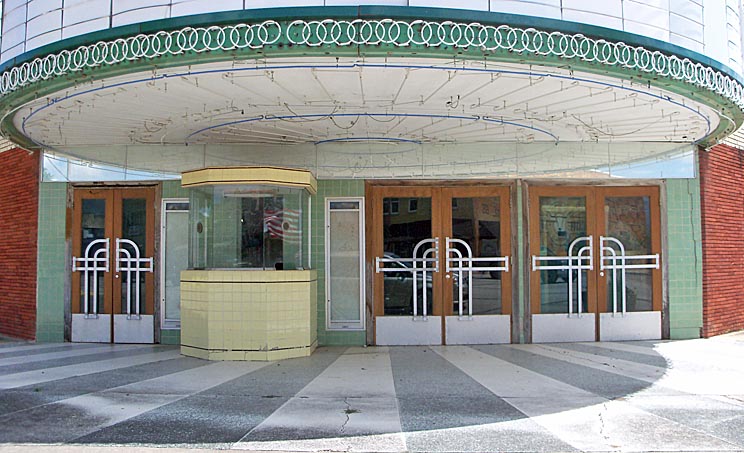 |
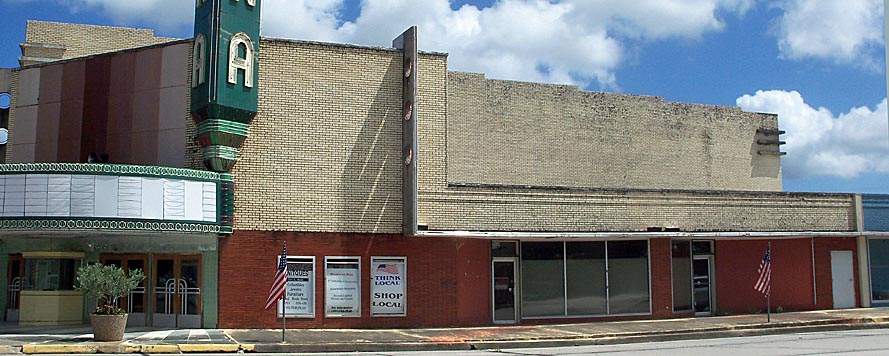 |
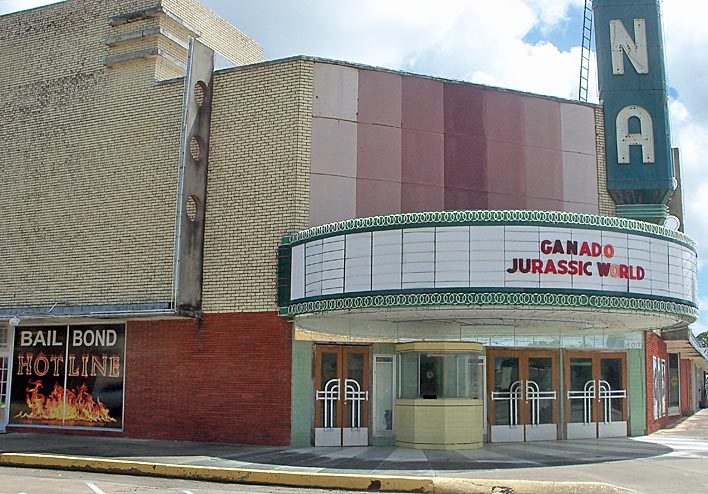 |
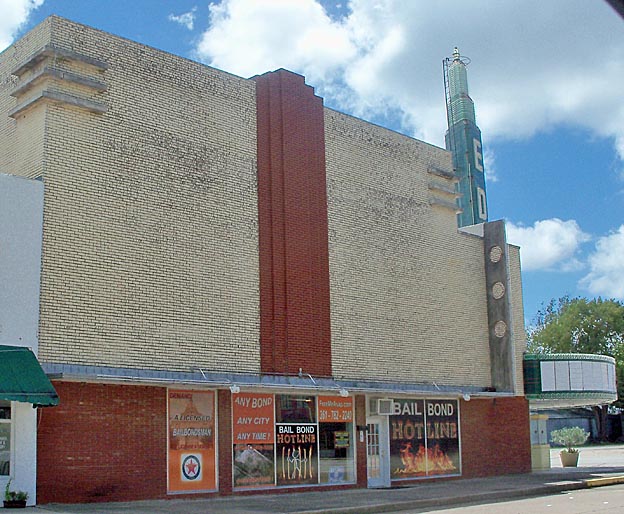 |
|
Copyright 2018-
Present by source entities |
|
| Created Apr 25, 2018 |
Updated Jun 27, 2018 |